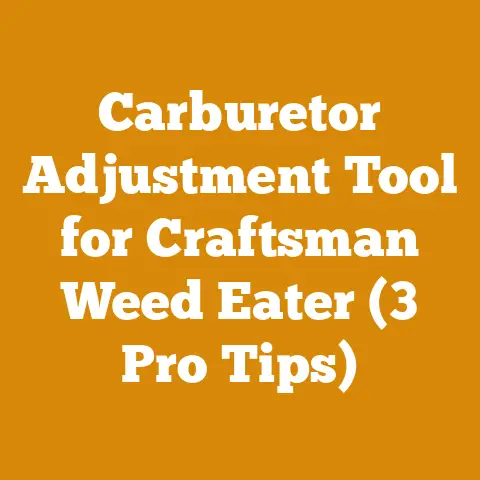Woody Plant Killer Guide (5 Proven Herbicides for Brush Control)
Have you ever felt like you’re waging a never-ending war against unwanted woody plants? I know I have. Picture this: I’m standing on my property, chainsaw in hand, having just spent hours clearing brush, only to see those same stubborn saplings popping up again weeks later. It’s frustrating, to say the least. That’s when I realized I needed a more strategic approach than just hacking away. I needed to understand the science behind brush control and find the right tools for the job.
Understanding the Enemy: Why Woody Plants Are So Tough
Before we jump into herbicides, let’s understand what makes woody plants so resilient. It’s not just that they grow quickly; it’s their entire structure and physiology that give them an edge.
Wood Anatomy and Properties
At the heart of a woody plant’s survival is its vascular system. Xylem transports water and nutrients from the roots to the leaves, while phloem carries sugars produced during photosynthesis throughout the plant. This efficient transport system allows woody plants to recover quickly from damage.
- Hardwood vs. Softwood: Hardwoods (like oak and maple) have a more complex cellular structure than softwoods (like pine and fir), making them generally denser and more resistant to herbicides. This difference in density affects how readily herbicides are absorbed and translocated within the plant.
- Bark: The bark acts as a protective layer, shielding the cambium (the layer responsible for new growth) from damage. Thick bark can also hinder herbicide absorption, which is why certain application methods are more effective than others.
- Root Systems: Many woody plants have extensive root systems that can store energy and nutrients, allowing them to resprout even after being cut down. Some, like aspen, even send up new shoots from their roots, creating entire colonies of genetically identical trees.
The Challenge of Brush Control
Controlling woody plants is challenging for several reasons:
- Persistence: They are perennial, meaning they live for multiple years and can regrow from their roots or stumps.
- Rapid Growth: Many invasive species grow quickly, outcompeting native plants and quickly taking over an area.
- Adaptability: Woody plants can thrive in a variety of conditions, making them difficult to eradicate completely.
- Seed Dispersal: Many woody plants produce abundant seeds that can be spread by wind, water, or animals, leading to new infestations.
Choosing Your Weapon: Proven Herbicides for Brush Control
Now that we understand the challenges, let’s explore the arsenal of herbicides available for brush control. It’s crucial to choose the right herbicide for the specific plant you’re targeting and the environment in which you’re working.
1. Glyphosate: The Broad-Spectrum Workhorse
Glyphosate (Roundup is a common brand name) is a non-selective, systemic herbicide that inhibits an enzyme essential for plant growth. It’s effective on a wide range of plants, including grasses, broadleaf weeds, and woody species.
- How it Works: Glyphosate is absorbed through the foliage and translocated throughout the plant, including the roots. It disrupts the production of amino acids, leading to plant death.
- Pros: Effective on a wide range of plants, relatively inexpensive, readily available.
- Cons: Non-selective (kills desirable plants as well as weeds), can be less effective on certain woody species with thick bark, potential for resistance with repeated use.
- Application: Foliar spray, cut-stump treatment.
My Experience with Glyphosate: I’ve used glyphosate extensively for controlling weeds and grasses around my property. However, I’ve found that it’s less effective on mature woody plants with thick bark. For those, I’ve had better luck with other herbicides or application methods.
Data Point: Studies have shown that glyphosate is more effective on actively growing plants, so timing your application is crucial.
2. Triclopyr: The Woody Plant Specialist
Triclopyr (Garlon is a common brand name) is a selective, systemic herbicide specifically designed for controlling woody plants and broadleaf weeds. It’s particularly effective on species that are resistant to glyphosate.
- How it Works: Triclopyr mimics plant hormones, causing uncontrolled growth and ultimately leading to plant death.
- Pros: Highly effective on woody plants, selective (less likely to harm grasses), can be used in a variety of application methods.
- Cons: More expensive than glyphosate, can be harmful to broadleaf plants, requires careful handling to avoid drift.
- Application: Foliar spray, cut-stump treatment, basal bark treatment.
My Experience with Triclopyr: I’ve found triclopyr to be my go-to herbicide for tackling stubborn woody plants like buckthorn and honeysuckle. The basal bark treatment method (which we’ll discuss later) has been particularly effective.
Data Point: Triclopyr is often formulated as an ester, which is more effective at penetrating the waxy cuticle of leaves and bark.
3. Imazapyr: The Long-Lasting Solution
Imazapyr (Arsenal is a common brand name) is a non-selective, systemic herbicide that provides long-term control of woody plants and weeds. It’s often used in forestry and right-of-way management.
- How it Works: Imazapyr inhibits an enzyme involved in amino acid synthesis, similar to glyphosate. However, it has a longer residual effect in the soil, preventing regrowth for an extended period.
- Pros: Long-lasting control, effective on a wide range of plants, can be used in a variety of application methods.
- Cons: Non-selective, can persist in the soil for a long time, potential for off-target movement, requires careful handling to avoid damage to desirable plants.
- Application: Foliar spray, cut-stump treatment, soil application.
My Experience with Imazapyr: I’ve used imazapyr in areas where I need long-term control of woody plants, such as along fence lines and in overgrown areas. However, I’m always careful to avoid applying it near desirable plants or in areas where runoff could contaminate water sources.
Data Point: Imazapyr can remain active in the soil for several months, so it’s important to consider the potential impact on future plantings.
4. 2,4-D: The Broadleaf Specialist
2,4-D is a selective, systemic herbicide that is primarily used to control broadleaf weeds. While it’s not as effective on woody plants as triclopyr or imazapyr, it can be useful for controlling certain species, especially when mixed with other herbicides.
- How it Works: 2,4-D mimics plant hormones, causing uncontrolled growth and ultimately leading to plant death.
- Pros: Effective on a wide range of broadleaf weeds, relatively inexpensive, can be used in combination with other herbicides.
- Cons: Less effective on woody plants than other herbicides, can be harmful to desirable broadleaf plants, potential for drift.
- Application: Foliar spray.
My Experience with 2,4-D: I’ve used 2,4-D primarily for controlling broadleaf weeds in my lawn and garden. While it’s not my first choice for woody plant control, I’ve found it to be a useful addition to my herbicide arsenal, especially when mixed with triclopyr.
Data Point: 2,4-D is more effective on young, actively growing plants, so timing your application is crucial.
5. Metsulfuron-methyl: The Low-Dose Powerhouse
Metsulfuron-methyl (Escort is a common brand name) is a selective, systemic herbicide that is effective on a wide range of broadleaf weeds and woody plants. It’s known for its low use rates, which can make it a cost-effective option for large areas.
- How it Works: Metsulfuron-methyl inhibits an enzyme involved in amino acid synthesis, similar to glyphosate and imazapyr.
- Pros: Effective on a wide range of plants, low use rates, can be used in a variety of application methods.
- Cons: Can be harmful to desirable broadleaf plants, potential for resistance with repeated use, requires careful handling to avoid drift.
- Application: Foliar spray, cut-stump treatment.
My Experience with Metsulfuron-methyl: I’ve used metsulfuron-methyl for controlling weeds and woody plants in pastures and rangelands. Its low use rates make it a cost-effective option for large areas.
Data Point: Metsulfuron-methyl is often used in combination with other herbicides to broaden its spectrum of control.
Application Techniques: Getting the Herbicide Where It Needs to Go
Choosing the right herbicide is only half the battle. You also need to apply it correctly to ensure it reaches the target plant and doesn’t harm desirable vegetation. Here are some common application techniques:
1. Foliar Spray: Coating the Leaves
Foliar spraying involves applying the herbicide directly to the leaves of the target plant. This method is most effective on actively growing plants with ample foliage.
- Pros: Relatively easy to apply, effective on a wide range of plants.
- Cons: Can be affected by wind and rain, potential for drift, may not be effective on plants with thick bark or waxy leaves.
- Equipment: Backpack sprayer, handheld sprayer, boom sprayer.
- Tips: Use a surfactant to improve herbicide adhesion and penetration, apply on a calm day to minimize drift, avoid spraying desirable plants.
My Experience with Foliar Spraying: I’ve used foliar spraying extensively for controlling weeds and small woody plants. However, I’ve learned that it’s crucial to use a surfactant and to apply the herbicide on a calm day to avoid drift.
2. Cut-Stump Treatment: Targeting the Root System
Cut-stump treatment involves applying the herbicide directly to the freshly cut stump of a woody plant. This method is particularly effective for preventing resprouting.
- Pros: Highly effective for preventing resprouting, minimizes off-target damage.
- Cons: Requires cutting down the plant, can be time-consuming, may not be effective on plants that send up new shoots from their roots.
- Equipment: Chainsaw, hatchet, paintbrush, squirt bottle.
- Tips: Apply the herbicide immediately after cutting the stump, saturate the entire cut surface, including the bark.
My Experience with Cut-Stump Treatment: I’ve found cut-stump treatment to be incredibly effective for preventing buckthorn and honeysuckle from resprouting. I always make sure to apply the herbicide immediately after cutting the stump, before it has a chance to dry out.
3. Basal Bark Treatment: Penetrating the Bark
Basal bark treatment involves applying the herbicide to the lower 12-18 inches of the trunk of a woody plant. This method is effective on thin-barked species and can be used year-round.
- Pros: Can be used year-round, effective on thin-barked species, doesn’t require cutting down the plant.
- Cons: Requires specialized equipment, can be more expensive than other methods, may not be effective on plants with thick bark.
- Equipment: Backpack sprayer with a low-pressure nozzle, oil-soluble herbicide.
- Tips: Use an oil-soluble herbicide, apply the herbicide evenly around the entire circumference of the trunk, avoid spraying the foliage.
My Experience with Basal Bark Treatment: I’ve had great success using basal bark treatment to control small- to medium-sized buckthorn and honeysuckle. It’s a convenient method because I can apply it year-round, even in the winter.
4. Soil Application: Systemic Uptake
Soil application involves applying the herbicide to the soil around the base of the target plant. The herbicide is then absorbed by the roots and translocated throughout the plant.
- Pros: Can provide long-term control, effective on plants with extensive root systems.
- Cons: Non-selective, can persist in the soil for a long time, potential for off-target movement, requires careful handling to avoid damage to desirable plants.
- Equipment: Granular applicator, liquid sprayer.
- Tips: Apply the herbicide evenly around the base of the plant, avoid applying it near desirable plants or in areas where runoff could contaminate water sources.
My Experience with Soil Application: I’ve used soil application sparingly, primarily for controlling woody plants in areas where I need long-term control and don’t have to worry about harming desirable vegetation.
5. Hack-and-Squirt: A Targeted Approach
The hack-and-squirt method involves making cuts into the bark of a woody plant and then applying the herbicide directly into the cuts. This method is effective for controlling larger trees and shrubs.
- Pros: Highly targeted, minimizes off-target damage, effective on larger trees and shrubs.
- Cons: Requires making multiple cuts, can be time-consuming, requires careful handling to avoid injury.
- Equipment: Hatchet, axe, squirt bottle.
- Tips: Make cuts at a downward angle, space the cuts evenly around the circumference of the trunk, apply the herbicide directly into the cuts.
My Experience with Hack-and-Squirt: I’ve used the hack-and-squirt method for controlling larger trees that are too big for basal bark treatment. It’s a bit more labor-intensive, but it’s a very effective way to get the herbicide directly into the plant’s vascular system.
Safety First: Protecting Yourself and the Environment
Working with herbicides requires careful attention to safety. Always read and follow the label instructions, and take precautions to protect yourself, others, and the environment.
Personal Protective Equipment (PPE)
- Gloves: Wear chemical-resistant gloves to protect your skin from herbicide exposure.
- Eye Protection: Wear safety glasses or goggles to protect your eyes from splashes and sprays.
- Long Sleeves and Pants: Wear long sleeves and pants to minimize skin exposure.
- Respirator: If you’re spraying herbicides in a confined space or are sensitive to chemicals, wear a respirator to protect your lungs.
- Boots: Wear waterproof boots to protect your feet from herbicide exposure.
Safe Handling Practices
- Read the Label: Always read and follow the label instructions carefully. The label is the law.
- Mix Herbicides Carefully: Mix herbicides in a well-ventilated area and avoid splashing or spilling.
- Apply Herbicides Safely: Apply herbicides on a calm day to minimize drift. Avoid spraying desirable plants or in areas where runoff could contaminate water sources.
- Store Herbicides Properly: Store herbicides in a locked cabinet or shed, out of reach of children and pets.
- Dispose of Herbicides Properly: Dispose of unused herbicides and empty containers according to local regulations.
Environmental Considerations
- Protect Water Sources: Avoid applying herbicides near water sources, such as streams, ponds, and wells.
- Minimize Drift: Apply herbicides on a calm day to minimize drift. Use drift-reduction nozzles and techniques.
- Protect Non-Target Plants: Avoid spraying desirable plants. Use selective herbicides and targeted application methods.
- Consider Wildlife: Be aware of the potential impact of herbicides on wildlife. Avoid applying herbicides in areas where wildlife are likely to be present.
My Personal Safety Protocol: Before I even open a container of herbicide, I make sure I have all my PPE on. I also take the time to read the label carefully and to understand the potential risks and precautions. I always mix herbicides in a well-ventilated area and I’m extremely careful to avoid drift when spraying.
Integrated Brush Control: A Holistic Approach
While herbicides are a valuable tool for brush control, they are most effective when used as part of an integrated approach that combines multiple strategies.
1. Prevention: The First Line of Defense
Preventing the establishment of unwanted woody plants is the most effective way to control them.
- Maintain Healthy Vegetation: Healthy vegetation can outcompete weeds and woody plants.
- Control Invasive Species: Identify and control invasive species early, before they become established.
- Monitor Your Property: Regularly monitor your property for new infestations of weeds and woody plants.
2. Mechanical Control: Manual Removal
Mechanical control involves physically removing weeds and woody plants.
- Hand Pulling: Hand pulling is effective for small weeds and seedlings.
- Cutting: Cutting can be used to control larger woody plants, but it’s important to follow up with herbicide treatment to prevent resprouting.
- Mowing: Mowing can be used to control grasses and broadleaf weeds, but it’s less effective on woody plants.
3. Cultural Control: Modifying the Environment
Cultural control involves modifying the environment to make it less favorable for weeds and woody plants.
- Mulching: Mulching can suppress weed growth and conserve soil moisture.
- Cover Cropping: Cover cropping can improve soil health and outcompete weeds.
- Prescribed Burning: Prescribed burning can be used to control woody plants and promote the growth of desirable vegetation.
4. Biological Control: Using Natural Enemies
Biological control involves using natural enemies, such as insects and diseases, to control weeds and woody plants.
- Grazing: Grazing can be used to control certain weeds and woody plants.
- Insecticides: Insecticides can be used to control insect pests that damage desirable vegetation.
- Herbicides: Herbicides can be used to control weeds and woody plants that compete with desirable vegetation.
My Integrated Approach: On my property, I use a combination of prevention, mechanical control, and herbicides to manage brush. I regularly monitor my property for new infestations of weeds and woody plants and I remove them by hand or with a chainsaw. I also use herbicides to control stubborn woody plants like buckthorn and honeysuckle.
Project Planning and Execution: A Step-by-Step Guide
Before you start spraying herbicides, it’s important to plan your project carefully to ensure that you achieve your desired results and minimize the risk of off-target damage.
1. Identify the Target Species:
Identify the specific woody plants that you want to control. This will help you choose the right herbicide and application method.
2. Assess the Site:
Assess the site to determine the extent of the infestation, the presence of desirable plants, and any potential environmental concerns.
3. Choose the Right Herbicide:
Choose the right herbicide for the target species and the site conditions. Consider the selectivity of the herbicide, the application method, and the potential for off-target damage.
4. Select the Appropriate Application Method:
Select the appropriate application method for the target species and the site conditions. Consider the size of the plants, the density of the infestation, and the presence of desirable plants.
5. Obtain the Necessary Equipment:
Obtain the necessary equipment, including personal protective equipment, sprayers, and applicators.
6. Mix the Herbicide According to Label Instructions:
Mix the herbicide according to the label instructions. Use clean water and a calibrated measuring device.
7. Apply the Herbicide Carefully:
Apply the herbicide carefully, following the label instructions and the chosen application method. Avoid spraying desirable plants or in areas where runoff could contaminate water sources.
8. Monitor the Results:
Monitor the results of the herbicide application and re-treat as necessary.
9. Document Your Activities:
Document your activities, including the date of application, the herbicide used, the application method, and the results. This will help you track your progress and make adjustments to your management plan as needed.
A Real-World Example: I recently helped a friend reclaim a neglected pasture that was overgrown with buckthorn and honeysuckle. We started by identifying the target species and assessing the site. We then chose triclopyr as our herbicide and decided to use a combination of cut-stump treatment and basal bark treatment. We obtained the necessary equipment and mixed the herbicide according to the label instructions. We applied the herbicide carefully, avoiding desirable plants and water sources. We monitored the results of the herbicide application and re-treated as necessary. Within a few months, the buckthorn and honeysuckle were dead and the pasture was starting to recover.
The Future of Brush Control: Innovations and Trends
The field of brush control is constantly evolving, with new technologies and strategies emerging all the time. Here are a few trends to watch:
- Precision Application: Precision application technologies, such as drones and GPS-guided sprayers, are allowing for more targeted and efficient herbicide applications.
- Biological Control: Biological control agents, such as insects and diseases, are being developed to control specific weeds and woody plants.
- Integrated Pest Management (IPM): IPM strategies are becoming increasingly popular, as they emphasize a holistic approach to pest management that combines multiple control methods.
- Reduced-Risk Herbicides: Reduced-risk herbicides, which are less toxic to humans and the environment, are being developed and promoted.
Final Thoughts: Winning the War Against Woody Plants
Controlling unwanted woody plants can be a challenging but rewarding task. By understanding the biology of woody plants, choosing the right herbicides, applying them safely and effectively, and using an integrated approach, you can reclaim your land and create a healthier, more diverse ecosystem.
Remember, it’s not just about killing plants; it’s about managing the landscape in a way that promotes the growth of desirable vegetation and supports a healthy ecosystem. It’s about finding that balance, that harmony between control and conservation.
So, grab your gloves, load up your sprayer, and get out there and start winning the war against woody plants! And remember, I’m always here to share my experiences and insights along the way.






